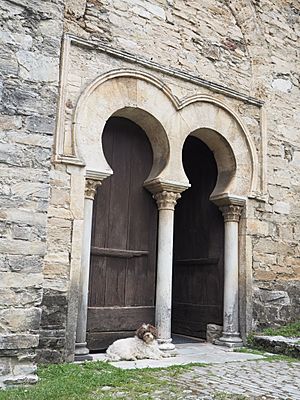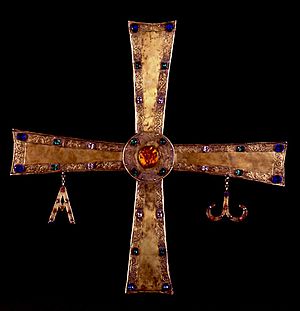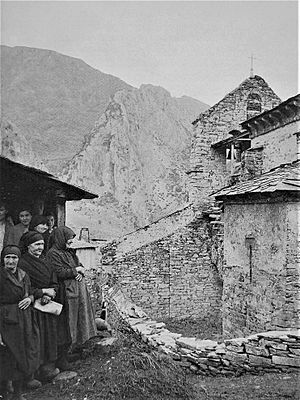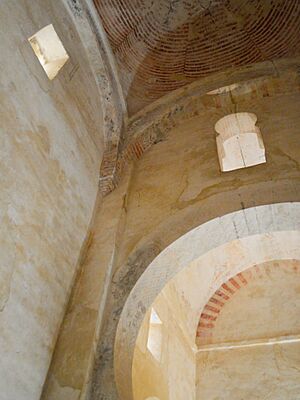Santiago de Peñalba facts for kids
Quick facts for kids Santiago de Peñalba |
|
|---|---|
| Church of Santiago de Peñalba | |
|
Spanish: Iglesia de Santiago de Peñalba
|
|
 |
|
| Location | Peñalba de Santiago, El Bierzo (Province of León) |
| Country | Spain |
| Denomination | Catholic Church |
| History | |
| Dedication | James the Great |
| Consecrated | 937 |
| Relics held | Cross of Peñalba |
| Architecture | |
| Heritage designation | Bien de Interés Cultural (BIC) |
| Architectural type | Mozarabic arquitecture |
| Style | Mozarabic |
The Church of Santiago de Peñalba is a very old church located in the small town of Peñalba de Santiago, in El Bierzo region of Spain. It's a fantastic example of Mozarabic art, which is a unique style from a long time ago.
This church was built in the early 900s, around the year 937. It was started by a religious leader named San Genadio and finished by his student, Abbot Solomon. This church is the only part left of a much larger monastery that used to be here.
The area where the church is built, called "Tebaida berciana," was once full of hermit monasteries. Hermits are people who live alone for religious reasons. This mountainous region helped them find the quiet they were looking for. San Genadio was very important in bringing this spiritual life to El Bierzo.
The Church of Santiago de Peñalba is considered a Site of Cultural Interest in Spain. It has been a National Historic-Artistic Monument since 1931, meaning it's a very important historical building.
Contents
A Look Back: History of the Church
The kingdom of León was a place of many changes and different cultures long ago. Its art was special because many different groups lived there, including Christians, Jews, and Muslims. The Church of Santiago de Peñalba was built during this time.
The church was designed by San Genadio, a Christian leader. It was built and decorated by skilled Christian workers who had learned from Arab styles. These workers were likely from Al-Andalus, a Muslim-ruled area in Spain. This shows how different cultures influenced each other back then. The monastery itself disappeared around the year 1283.
The church was built between 931 and 937, during the rule of King Ramiro II of León. King Ramiro II even gave the church special gifts, like the Cross of Peñalba in 940. This cross is now a symbol of the Bierzo region. Even with its treasures, the monastery often had money problems and needed donations.
After the monastery was gone, the Church of Santiago de Peñalba became a local parish church for the nearby town. Because it was in an isolated area, the church stayed mostly the same for centuries. It wasn't until historians like Manuel Gómez-Moreno visited in 1909 that its historical importance became widely known.
Unique Architecture
The Church of Santiago de Peñalba is built with slate and limestone. From the outside, it looks a bit like older Visigothic churches with a cross shape. However, its inside structure is quite different. It has six main parts, with four along the main path and two smaller chapels that form a cross.
The roofs are made of slate and have wide edges supported by special brackets called corbels. These corbels are decorated with cool geometric shapes and flower designs, which are common in Mozarabic churches. The bell tower is actually separate from the main church building.
The main entrance is on the south side. It has a striking doorway with two large horseshoe arches. These arches are supported by marble columns with decorated tops. This doorway is very decorative and creates a small porch.
Inside the Church
Inside, the church is special because it has two main altar areas, called apses, facing each other. This was very unusual for its time. The second apse, facing the sunset, was used as a burial place for San Genadio.
The main part of the church has a square outside but a horseshoe shape inside. The ceiling here has a special "gallon vault" (a dome with curved sections like orange slices), which was a clever building technique. The other parts of the church have simpler barrel-shaped ceilings.
The main altar area, called the presbytery, is taller than the rest. It's reached through a horseshoe arch and has an eight-sectioned gallon vault. The church's design allows for large openings and more horseshoe arches.
The inside of the church also has beautiful decorations. Recently, old paintings from the Caliphal period were found. These paintings show plants, geometric patterns, and even look like brick.
Ancient Wall Paintings
The church's walls are covered with ancient paintings from the Caliphate period. These paintings once covered the whole building. You can still see them on the arches of the central dome and in the two apses.
These paintings were done in three different stages. The oldest ones are from the 10th century, the same time the church was built. They were made using a technique called fresco painting. This means the artists painted on wet plaster, which helped the colors soak in and last a long time.
The paintings show patterns that look like bricks, as well as plants and geometric shapes. The red paint at the bottom of the walls is very similar to paint found in Medina Azahara in Córdoba. This shows the high quality of the art and materials used. These paintings have been partly restored since 2004.
Medieval Graffiti
Inside the church, especially on the choir walls, you can find many medieval graffiti. These are drawings scratched into the plaster, showing people, shapes, and even animals. They offer a glimpse into the daily lives of the people who used the church long ago.
Some of these drawings might have been practice sketches by monks before they drew on paper. Paper was very expensive back then! Other drawings might have been made by monks for fun or to show their own identity.
Some interesting graffiti include two lions, a hunting scene, and a monk in a blessing pose. There are also writings that repeat the name "GĒNADII," referring to San Genadio.
Important Relics and Treasures
The Church of Santiago de Peñalba has been home to several important historical items over the centuries.
The Cross of Peñalba
The Cross of Peñalba is a special cross given in the 10th century by King Ramiro II of León. He gave it to San Genadio to thank Saint James (Santiago) for help in a battle in 939. Today, this cross is a major symbol of the El Bierzo region. It is currently displayed in the León Museum.

Chalice and Paten
Like the Cross, the Chalice and Paten (a cup and plate used in church services) from Santiago de Peñalba also came from the old monastery. Abbot Pelayo ordered them to be made in the mid-12th century when the monastery was very important. These beautiful items are now part of the permanent collection at the Louvre Museum in Paris.
San Genadio Chess Pieces
The Bolos de San Genadio are four chess pieces from the 9th century that came from Santiago de Peñalba. They are thought to be the oldest chess pieces in Europe! They were likely brought by Mozarabic hermits from Al-Ándalus to the Kingdom of León. Four pieces carved from goat's horn are still preserved: two towers (one broken), a knight, and a bishop.
Gallery
- Santiago de Peñalba
See also
 In Spanish: Iglesia de Santiago (Peñalba de Santiago) para niños
In Spanish: Iglesia de Santiago (Peñalba de Santiago) para niños












